Roofing Companies Waynesboro
Top 10 Roofing Companies in Waynesboro
Get 3 FREE Roofing Companies quotes for your project today! Compare profiles, reviews, accreditations, portfolio, etc... and choose the best service.
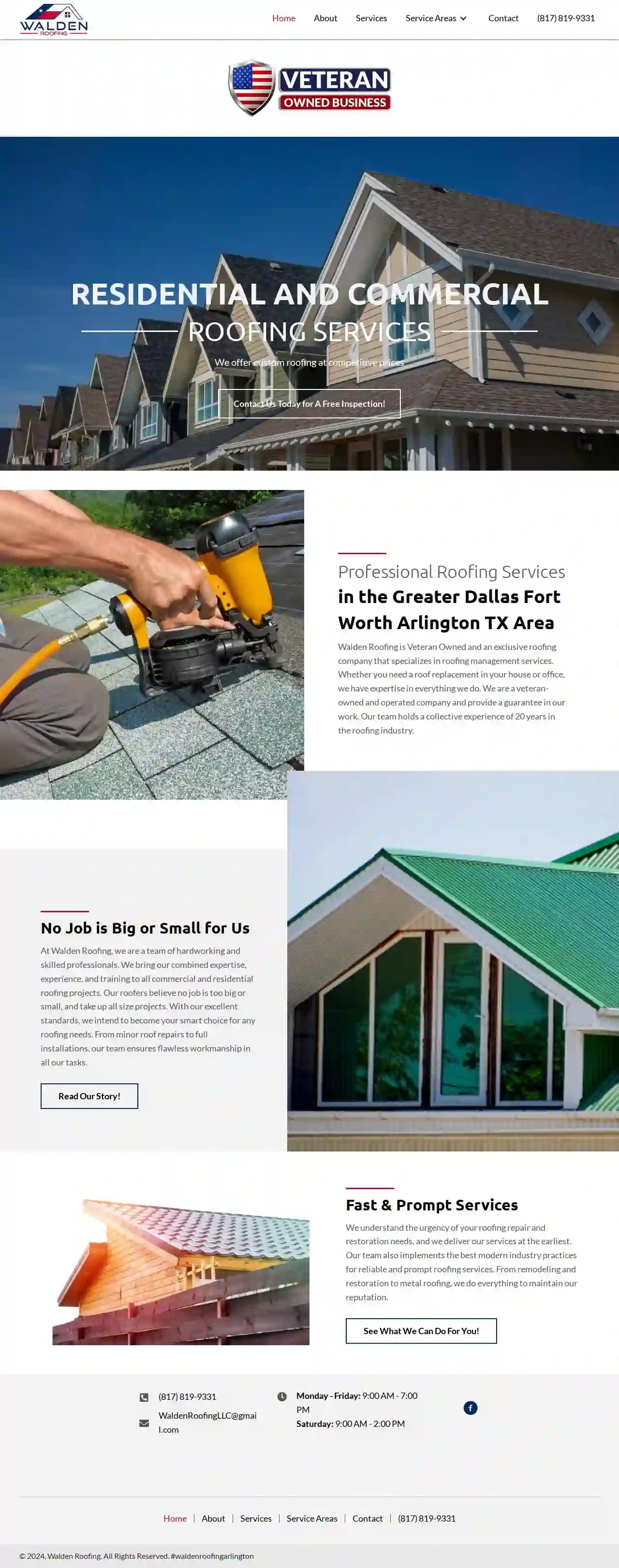
Walden Roofing - Veteran Owned
533 reviewsArlington, USWalden Roofing is Veteran Owned and one of the preferred roofing service providers in the Greater Dallas Fort Worth Metro area. Integrity, quality, and care are the business values that help us raise our standards to excel in the roofing industry. With our talented team & quality materials, we aim to go beyond your expectations. Our team collectively brings 20 years of roofing experience to the table and ensures to give 100% satisfying results. Roger Walden is the founder of Walden Roofing. Roger has worked in the construction field for 15 years. Roger formed Walden Roofing LLC, because he believes in quality, and wants the best for his community. His goal is to provide the best-in-class roofing service to the community that big corporate agencies cannot offer. We have more than 20 years of experience in the industry. We offer reliable roofing services at competitive prices. We only use the best quality products and materials. We are honest and fast and provide exceptional customer service. We also create custom roofing or repair project to fit any budget.
- Services
- Why Us?
- Accreditations
- Our Team
- Gallery
Get Quote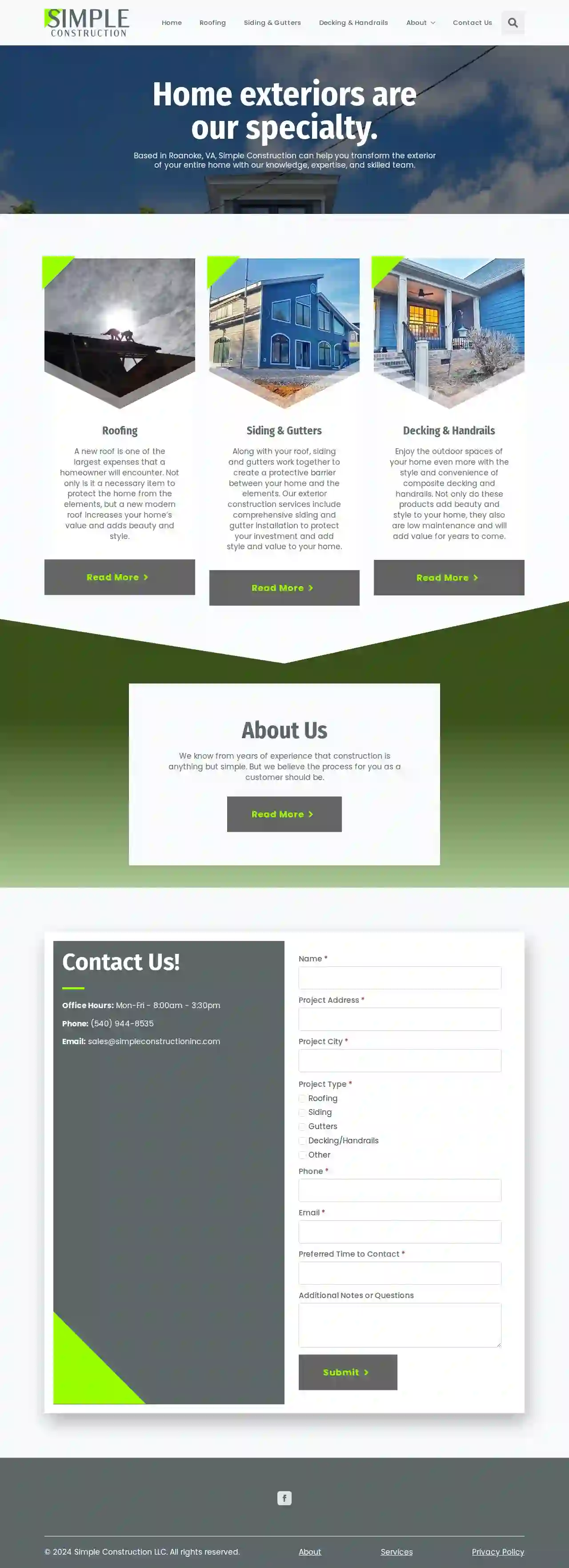
Simple Construction
512 reviewsRoanoke, 24018, USHome exteriors are our specialty. Based in Roanoke, VA, Simple Construction can help you transform the exterior of your entire home with our knowledge, expertise, and skilled team. A new roof is one of the largest expenses that a homeowner will encounter. Not only is it a necessary item to protect the home from the elements, but a new modern roof increases your home’s value and adds beauty and style. Along with your roof, siding and gutters work together to create a protective barrier between your home and the elements. Our exterior construction services include comprehensive siding and gutter installation to protect your investment and add style and value to your home. Enjoy the outdoor spaces of your home even more with the style and convenience of composite decking and handrails. Not only do these products add beauty and style to your home, they also are low maintenance and will add value for years to come. We know from years of experience that construction is anything but simple. But we believe the process for you as a customer should be. At Simple Construction, we focus on clear communication and responsive customer service from the initial contact to the final walkthrough. We offer comprehensive exterior construction services for homeowners and contractors in Southwest Virginia. From roofing to siding, gutters to decking and handrails, we strive to make the construction process simple.
- Services
- Why Us?
- Our Team
- Testimonials
- Gallery
Get Quote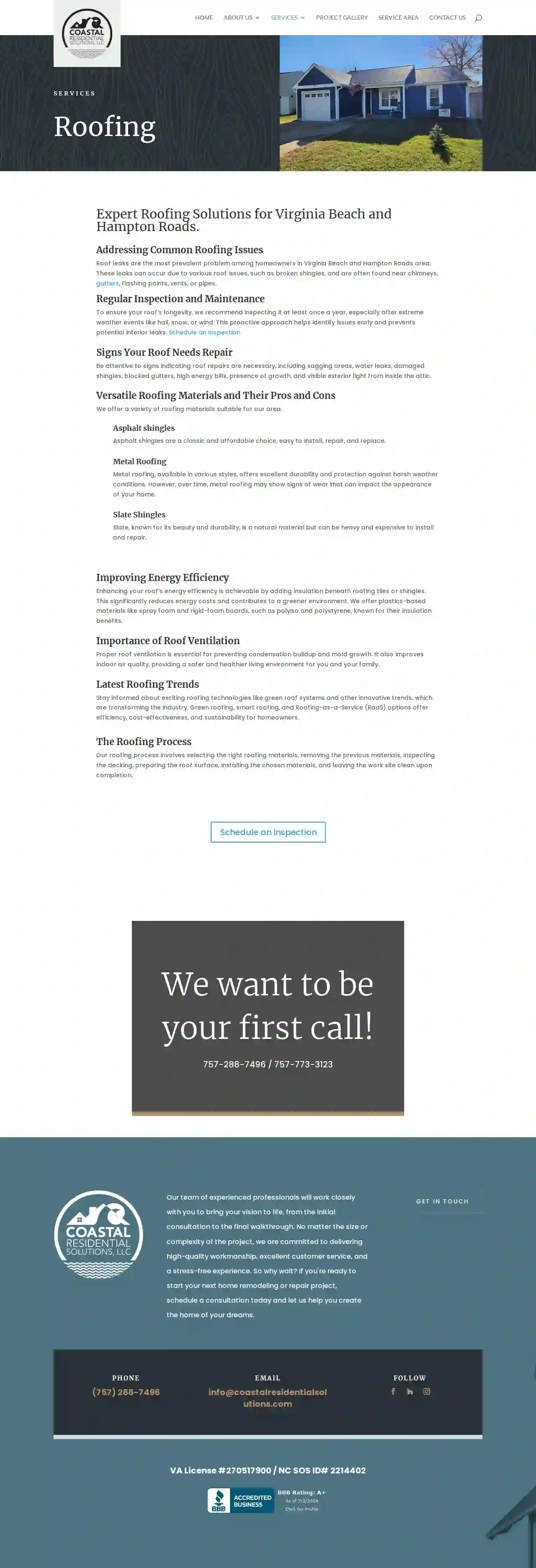
Coastal Residential Solutions, LLC
520 reviewsSuite 106, 2681 Production Road, Virginia Beach, 23454, USCoastal Residential Solutions is your partner in home remodeling and repair, transforming houses into dream homes. Serving all of Coastal Virginia, they specialize in both exteriors and interiors, offering a full range of services from roofing and siding to kitchen and bathroom renovations. Their team of experienced professionals is dedicated to delivering high-quality workmanship, excellent customer service, and a stress-free experience for every client. Whether you're dreaming of a complete overhaul or just need a few repairs, Coastal Residential Solutions is committed to helping you create the home of your dreams.
- Services
- Why Us?
- Accreditations
- Our Team
- Testimonials
- Gallery
Get Quote
Mid-Atlantic Roofing Supply of Norfolk, VA
51 reviews1129 Production Road, Norfolk, 23502, USOne of the 13 original colonies that later formed the United States, The Commonwealth of Virginia is a spacious, populous, thriving state boasting a long coastline and beautiful mountains. Throughout Virginia, cities and towns are enjoying a construction boom that demands a reliable source of materials. Mid-Atlantic Roofing Supply is your premier source for Virginia wholesale commercial and residential roofing materials. Our locally owned and operated location in Virginia is strategically placed for expedited supply and delivery throughout the Commonwealth to your residential and commercial projects. Our signature Delivery Promise guarantees that you will have what you need where you need it when you need it to keep your project on time and on budget. Get the professional services, roofing products and seasoned expertise you need in Virginia at Mid-Atlantic Roofing Supply. We carry a wide variety of products and accessories from only the best quality brands to help you with any size roofing project. Large construction companies, local contractors, home builders and others across Virginia and other states trust us to provide everything needed for superior quality roofing and building projects. Single-family homes Second homes Beach homes Retirement communities Exclusive communities Subdivisions Apartment buildings Condos Businesses Warehouses Hotels Office buildings Government buildings Manufacturing centers Mid-Atlantic Roofing Supply also offers special commercial services you can’t find just anywhere, including architectural support and assistance with crafting estimates, drawings and submittals. Our team can help you win more projects and approvals to make your commercial roofing business thrive. Learn more about the latest industry best practices, products, training and more at our Virginia location. Our knowledgeable and talented team always seeks to build strong and mutually beneficial relationships with our clients and vendors – your success is our goal. Mid-Atlantic Roofing Supply is your experienced partner that delivers superior services and products to keep your residential or commercial project moving along without delay. From product selection to financing to shipping, we take care of our clients. Visit our Virginia location and see for yourself why we are a leading roofing supply distributor.
- Services
- Why Us?
- Gallery
Get Quote
Big Lick Roofing
4.885 reviewsRoanoke, VA, 501 Marshall Ave SW, 24016, USRoofing contractor serving greater Roanoke & The Roanoke Valley. We are a GAF Master Elite roofing company, installing new roofs that last with an unmatched warranty. Our mission is to provide high-quality roofing installations at competitive rates with outstanding customer service. We handle steep slope commercial roof replacements, residential roof replacements, and roof repairs. We are locally owned and operated, licensed and insured, and offer competitive prices, quick turnaround times, and unmatched workmanship and material warranty. We also offer financing options and a 'Peace Of Mind' warranty with all GAF shingle roof replacements.
- Services
- Why Us?
- Accreditations
- Our Team
- Testimonials
- Gallery
Get Quote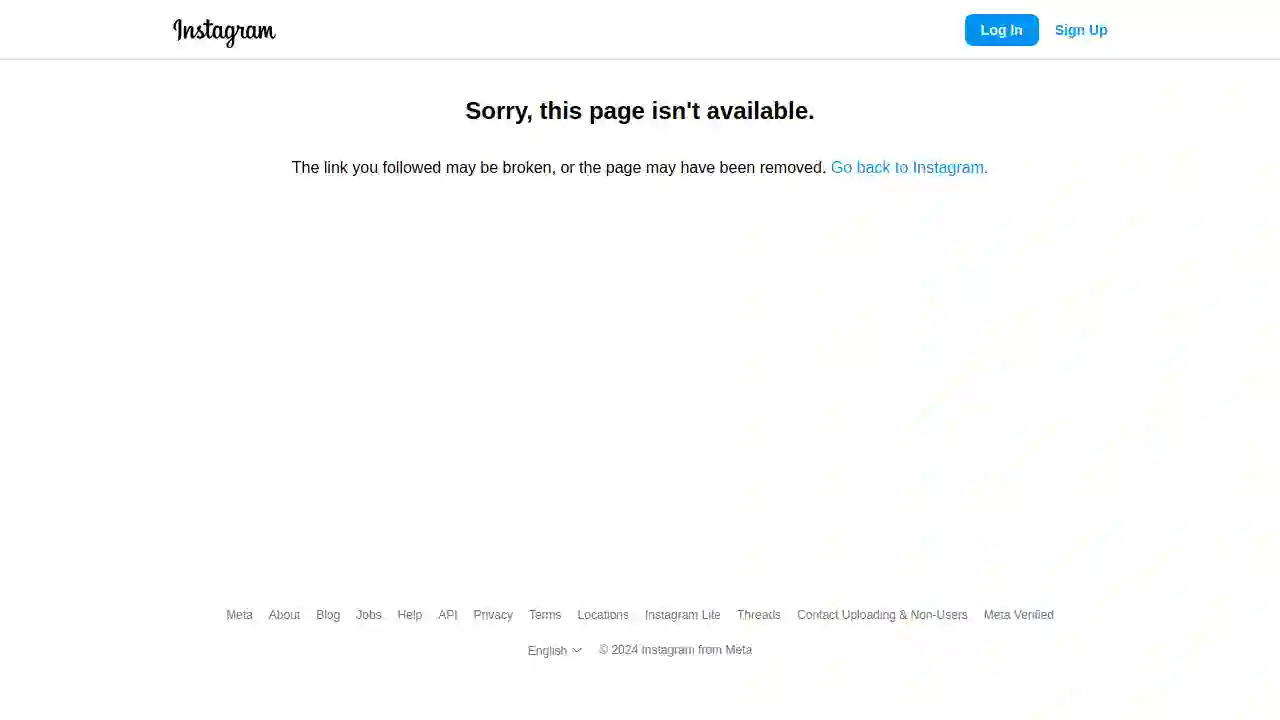
Guarantee Roofing LLC
519 reviews123 Main St, Anytown, 12345, USGuarantee Roofing LLC is a family-owned and operated roofing company that has been serving the community for over 15 years. Our mission is to provide exceptional roofing services to our customers, ensuring their homes and businesses are protected from the elements. We take pride in our work, using only the highest-quality materials and employing skilled craftsmen to ensure a job well done. Our team is dedicated to providing excellent customer service, and we strive to build long-lasting relationships with our clients. Whether you need a new roof installation, repair, or maintenance, we're here to help.
- Services
- Why Us?
- Accreditations
- Our Team
- Testimonials
- Gallery
Get Quote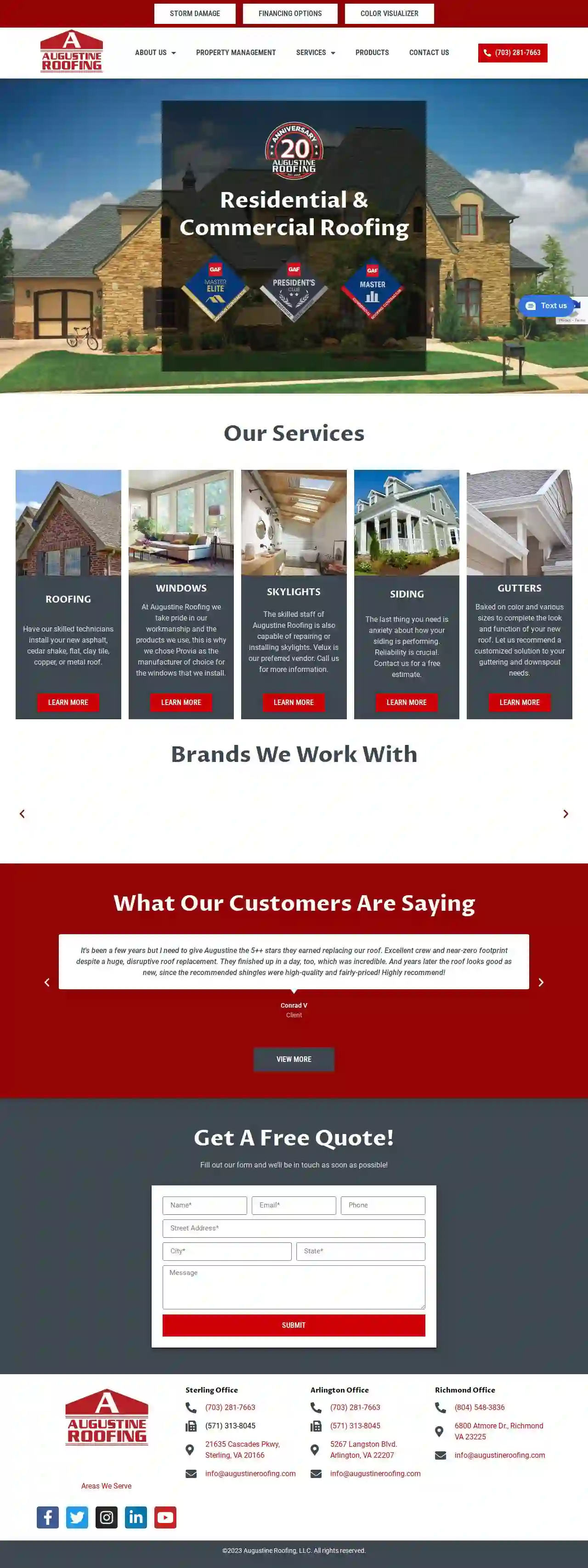
Augustine Roofing
523 reviews21635 Cascades Pkwy, Sterling, 20166, USAt Augustine Roofing, we pride ourselves on providing top-notch roofing services to our customers. With years of experience and a team of skilled technicians, we can handle any roofing need you may have. From roof installation to repair and maintenance, we're here to help. Our commitment to quality and customer satisfaction has earned us numerous awards and recognition, including GAF Master Elite and President's Club. We're dedicated to providing the best possible service to our customers, and we're confident that you'll be satisfied with our work. Contact us today to learn more about our services and how we can help you with your roofing needs.
- Services
- Why Us?
- Accreditations
- Our Team
- Testimonials
- Gallery
Get Quote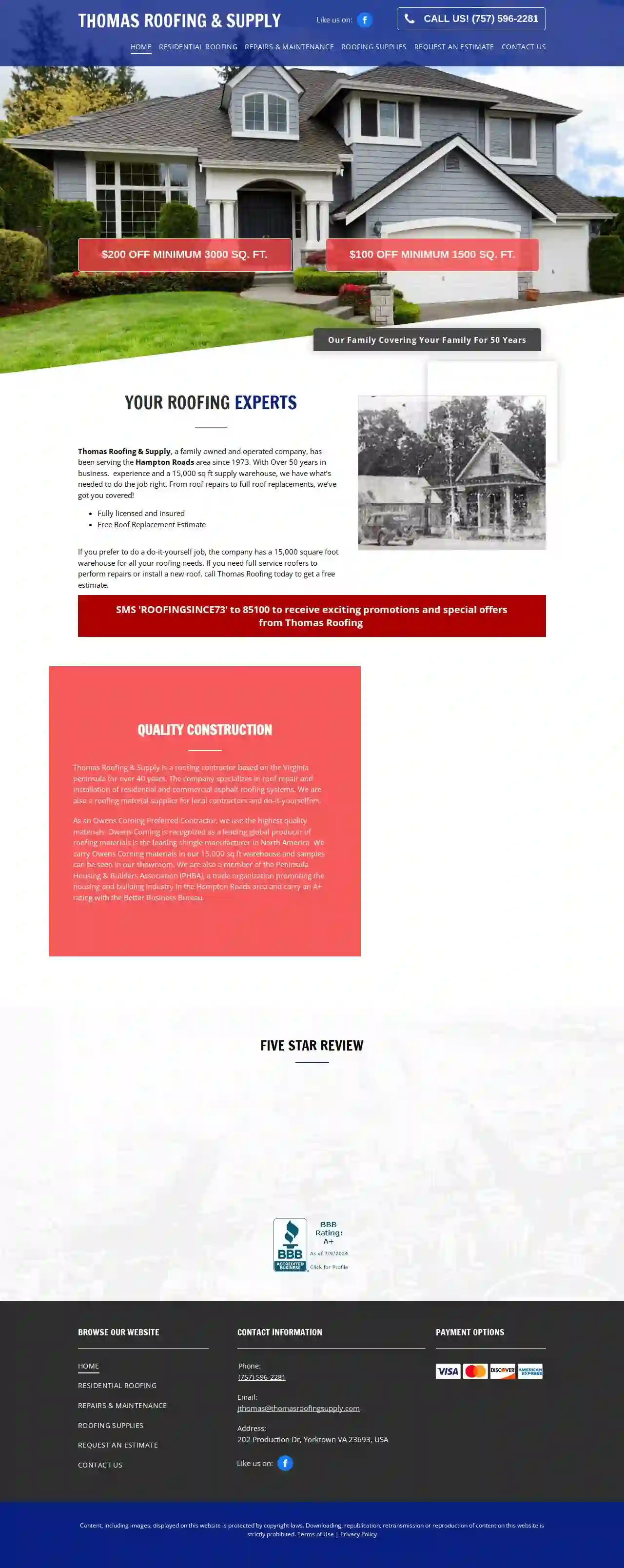
Thomas Roofing & Supply Inc
343 reviews202 Production Dr, Yorktown, 23693, USThomas Roofing & Supply, a family owned and operated company, has been serving the Hampton Roads area since 1973. With Over 50 years in business experience and a 15,000 sq ft supply warehouse, we have what’s needed to do the job right. From roof repairs to full roof replacements, we’ve got you covered! We are also a roofing material supplier for local contractors and do-it-yourselfers. As an Owens Corning Preferred Contractor, we use the highest quality materials. Owens Corning is recognized as a leading global producer of roofing materials is the leading shingle manufacturer in North America. We carry Owens Corning materials in our 15,000 sq ft warehouse and samples can be seen in our showroom. We are also a member of the Peninsula Housing & Builders Association (PHBA), a trade organization promoting the housing and building industry in the Hampton Roads area and carry an A+ rating with the Better Business Bureau.
- Services
- Why Us?
- Accreditations
- Our Team
- Testimonials
- Gallery
Get Quote
Cenvar Roofing
51 reviewsRoanoke, USWelcome to Cenvar Roofing - Roanoke. The Cenvar Roofing team is proud to be your choice for Roanoke roofing experts. From roofing repair, replacement, and everything in between, we are your top Roanoke area roofing contractors. At Cenvar Roofing Roanoke, our mission is to offer the highest quality roofing services, tailored to the unique needs of homeowners in the Roanoke area. Our team of seasoned professionals is committed to delivering unparalleled workmanship and customer satisfaction since our founding in 2012. We prioritize customer satisfaction above everything and this is evident throughout each step of your roofing project, from conception to completion. If you are in need of a roof repair or replacement in the Roanoke, VA area, contact us today to request a free estimate appointment. We would be happy to serve you! Comprehensive Roofing Company Near You. Innovative Solutions for Long-lasting and Attractive Roofs. From asphalt shingles to metal, to specialty shingles, when it comes to residential roofing services, Cenvar Roofing in Roanoke, VA does it all. Your home is probably the most expensive asset that you own, which means that you need to do everything in your power to protect it well. One of the most effective ways to protect your home and family is to make sure you have a high-quality roof over your head.
- Services
- Why Us?
- Accreditations
- Our Team
- Testimonials
- Gallery
Get Quote
E&J Remodelers LLC
55 reviews5908 Buckminister Ln, Virginia Beach, 23462-1434, USE & J Remodelers LLC is a leading roofing and remodeling contractor serving Virginia Beach, Hampton Roads, Chesapeake, and Norfolk. With over 20 years of experience, we are dedicated to providing high-quality services and exceptional customer satisfaction. Our team of experts is committed to using the best materials and techniques to ensure that your project is completed to the highest standards. We offer a wide range of services, including new roof installation, roof repair, storm damage repair, kitchen remodeling, bathroom remodeling, siding installation, residential painting, and framing. We are licensed and insured, giving you peace of mind knowing that your project is in capable hands.
- Services
- Why Us?
- Accreditations
- Gallery
Get Quote
Over 17,196+ Roofing Contractors onboarded
Our roofing contractors operate in Waynesboro and surrounding areas!
Roofyng.com has curated and vetted Top Roofing Companies near Waynesboro. Find a top & reliable contractor today.
Frequently Asked Questions About Roofing Companies
- Regular Inspections: Inspect your roof at least twice a year for signs of damage or wear and tear.
- Gutter Cleaning: Clean gutters and downspouts regularly to prevent clogs and ensure proper drainage.
- Tree Trimming: Trim overhanging branches to avoid damage from falling debris and reduce shade, preventing moss growth.
- Proper Ventilation: Ensure good attic ventilation to regulate temperature and moisture.
- Timely Repairs: Address any damage promptly to prevent escalation.
- Listed Buildings: Buildings with historical or architectural significance.
- Conservation Areas: Areas with special architectural or historical character.
- Changes to Roof Design: If you're making significant alterations to the roof's design, such as adding a dormer window or changing the pitch.
How do I prevent roof damage?
What is fascia, and why is it important?
Do I need planning permission to replace my roof in the USA?
What is the difference between a roofer and a general contractor?
Roofer: Specializes in roof installations, repairs, and replacements. They have expertise in roofing materials, techniques, and safety practices specific to roofing.
General Contractor: Oversees and manages entire construction projects, including hiring and coordinating subcontractors, such as roofers, electricians, plumbers, etc. They handle overall project planning, scheduling, and budgeting.
For roofing projects, it's generally best to hire a roofing contractor who specializes in roof work.
How do I prevent roof damage?
- Regular Inspections: Inspect your roof at least twice a year for signs of damage or wear and tear.
- Gutter Cleaning: Clean gutters and downspouts regularly to prevent clogs and ensure proper drainage.
- Tree Trimming: Trim overhanging branches to avoid damage from falling debris and reduce shade, preventing moss growth.
- Proper Ventilation: Ensure good attic ventilation to regulate temperature and moisture.
- Timely Repairs: Address any damage promptly to prevent escalation.
What is fascia, and why is it important?
Do I need planning permission to replace my roof in the USA?
- Listed Buildings: Buildings with historical or architectural significance.
- Conservation Areas: Areas with special architectural or historical character.
- Changes to Roof Design: If you're making significant alterations to the roof's design, such as adding a dormer window or changing the pitch.
What is the difference between a roofer and a general contractor?
Roofer: Specializes in roof installations, repairs, and replacements. They have expertise in roofing materials, techniques, and safety practices specific to roofing.
General Contractor: Oversees and manages entire construction projects, including hiring and coordinating subcontractors, such as roofers, electricians, plumbers, etc. They handle overall project planning, scheduling, and budgeting.
For roofing projects, it's generally best to hire a roofing contractor who specializes in roof work.